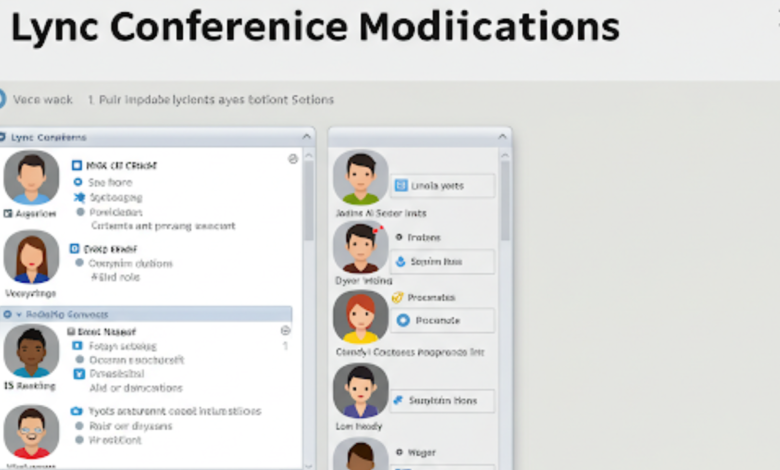lync conf mods A Comprehensive Guide

Microsoft Lync, now seamlessly integrated into Microsoft Teams, revolutionized online communication and collaboration. While its legacy continues to influence modern workplace communication, understanding its core functionalities, lync conf mods particularly its diverse conference modes, remains crucial for effective remote work and team interactions. This guide delves deep into the intricacies of Lync conference modes, exploring their capabilities and providing valuable insights for optimal utilization.
Lync, at its core, aimed to bridge the gap between traditional communication methods like phone calls and modern digital interactions. It offered a unified platform for instant messaging, voice and video conferencing, and file sharing, all seamlessly integrated within a familiar Microsoft environment. This convergence of communication channels facilitated more efficient and productive interactions, fostering a more connected and collaborative workforce.
The significance of Lync’s conference modes lies in their adaptability. Whether it’s a quick team meeting, a formal presentation, or a casual brainstorming session, Lync offered a range of options to cater to diverse communication needs. These modes, encompassing audio, video, and data sharing capabilities, empowered users to choose the most suitable approach for each specific scenario, optimizing both productivity and engagement.
From simple phone calls to sophisticated video conferences with screen sharing, Lync provided a versatile toolkit for remote communication. Understanding the nuances of each mode and their respective strengths allowed users to select the most appropriate option, ensuring smooth and effective interactions, regardless of location or time constraints.
Exploring Lync Conference Modes: A Deep Dive
Lync offered a rich array of conference modes, each designed to cater to specific communication needs. Audio conferencing, a cornerstone of Lync, provided flexibility with options like phone conferencing, computer audio, and IP audio. Phone conferencing, while traditional, offered simplicity and accessibility, enabling participants to dial in using a standard telephone. Computer audio, utilizing the computer’s microphone and speakers or a dedicated headset, provided a convenient option for those already working at their desks. IP audio, leveraging the internet for voice transmission, offered high-quality audio and enhanced features, though it required network stability and appropriate hardware.
Video conferencing, a key feature of Lync, transformed remote meetings into more engaging and immersive experiences. Participants could see and interact with each other in real-time, fostering a sense of presence and facilitating better understanding and rapport. Content sharing capabilities, including screen sharing and application sharing, further enriched video conferences, enabling seamless collaboration on presentations, documents, and other materials. Whiteboard functionality provided a virtual canvas for brainstorming, ideation, and collaborative problem-solving, enhancing creativity and teamwork.
Lync seamlessly integrated instant messaging (IM) into its conference environment, enabling participants to engage in quick side conversations, share information discreetly, or make announcements without disrupting the main discussion. Presence indicators, displaying the availability status of colleagues (e.g., available, busy, away), provided valuable context, allowing participants to gauge the appropriate timing for interruptions or further communication.
Data collaboration was another key aspect of Lync’s conference capabilities. File sharing and transfer, facilitated through integrated tools, enabled participants to easily share documents, presentations, and other relevant materials during meetings. This streamlined information exchange, fostering greater efficiency and reducing the need for separate file transfer mechanisms. Whiteboarding and annotation features, as mentioned earlier, provided a dynamic platform for collaborative work on documents, presentations, and other digital content.
Advanced Lync Conference Features: Enhancing Collaboration
Lync incorporated several advanced features that further enhanced its conference capabilities. Recording and playback functionality, a valuable asset for documentation and training, allowed users to capture entire conference sessions for later review or sharing. This feature proved particularly useful for capturing key decisions, presentations, and training sessions for future reference.
Transcription services, while not always readily available, offered the potential to automate the conversion of spoken words into text, significantly improving accessibility and enabling more efficient note-taking and documentation. This feature, though still evolving, demonstrated the potential of leveraging technology to enhance the accessibility and usability of conference recordings.
Lync also supported integration with third-party applications and services, expanding its functionality and interoperability. This flexibility allowed users to seamlessly incorporate other tools and platforms into their Lync-based workflows, creating a more integrated and efficient communication ecosystem.
Accessibility was a key consideration in Lync’s design. Features like captioning, screen reader support, and alternative input methods ensured inclusivity and accessibility for users with disabilities. These features demonstrated Lync’s commitment to providing an equitable and inclusive communication platform for all users.
Best Practices for Lync Conferences: Maximizing Effectiveness
Effective Lync conferences require careful planning and preparation. Setting a clear agenda, inviting the necessary participants, and conducting thorough technical checks prior to the meeting are crucial steps in ensuring a smooth and productive session.
You May Also Read: https://fundaliy.co.uk/depomin82/



